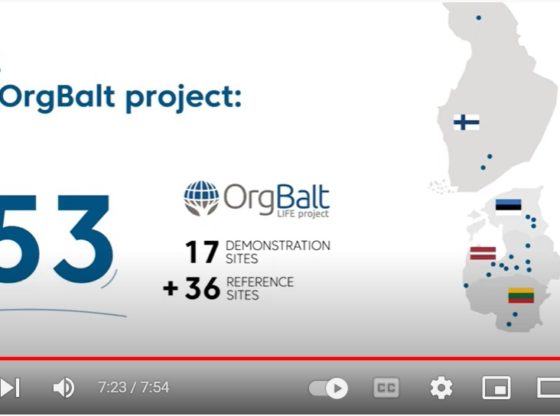The second short documentary of the LIFE OrgBalt project has been prepared. In the documentary the process of greenhouse gas (GHG) measurement in the project is presented together with explanations on the methods applied. Project experts tell why it is crucial to improve the quality of GHG data and how it will contribute to the quality of national GHG inventory reports and planning of climate policy.
As described in LIFE OrgBalt documentary: “We are measuring 3 main greenhouse gas emissions: Carbon dioxide, Methane and Nitrous oxide by performing soil heterotrophic respiration measurements using closed chamber method and photosynthesis measurements using transparent chamber method.
In addition, we are measuring and sampling other environmental data, such as groundwater level and chemical composition measurements, soil temperature, moisture measurements and soil chemical composition measurements. In parallel we are measuring aboveground and belowground biomass production including fine-root production, litter production and decomposition by litter and biomass production. There are slight differences in measurements in agricultural lands and forest lands.”
Andis Lazdiņš Senior researcher of the Latvian State Forest Research Institute “Silava” emphasizes: “The main task of the project is to provide the data needed to correctly calculate greenhouse gas emissions and carbon sequestration in the soil.”
Four short documentaries in total will be produced within the LIFE OrgBalt project. The project’s first short film is also available on the project’s website, introducing viewers to the project’s objectives, scope and expected results: HERE.
The project LIFE OrgBalt focuses on exploring and demonstrating the potential for GHG reduction and increase of carbon sequestration in fertile organic soil management. An important part of the project outcomes will be developing and implementing climate change mitigation measures that promote a scientifically sound approach to land use and climate policy planning documents.
LIFE OrgBalt developed three sites demonstrating continuous cover forestry management aiming to reduce CO2 emissions from forestry drained peat in Finland and 14 demonstration sites established in Latvia, both on agricultural and forest land. Moreover, GHG fluxes are monitored in 53 sites (including demonstration sites) providing comprehensive data for the whole area of the Baltic States, Finland, and Germany.
Project “Demonstration of climate change mitigation potential of nutrient rich organic soils in Baltic States and Finland” (LIFE OrgBalt, LIFE18 CCM/LV/001158) is implemented with financial support from the LIFE Programme of the European Union and State Regional Development Agency of the Republic of Latvia. www.orgbalt.eu
The information reflects only the LIFE OrgBalt project beneficiaries view and the European Climate, Infrastructure and Environment Executive Agency is not responsible for any use that may be made of the information contained therein.


